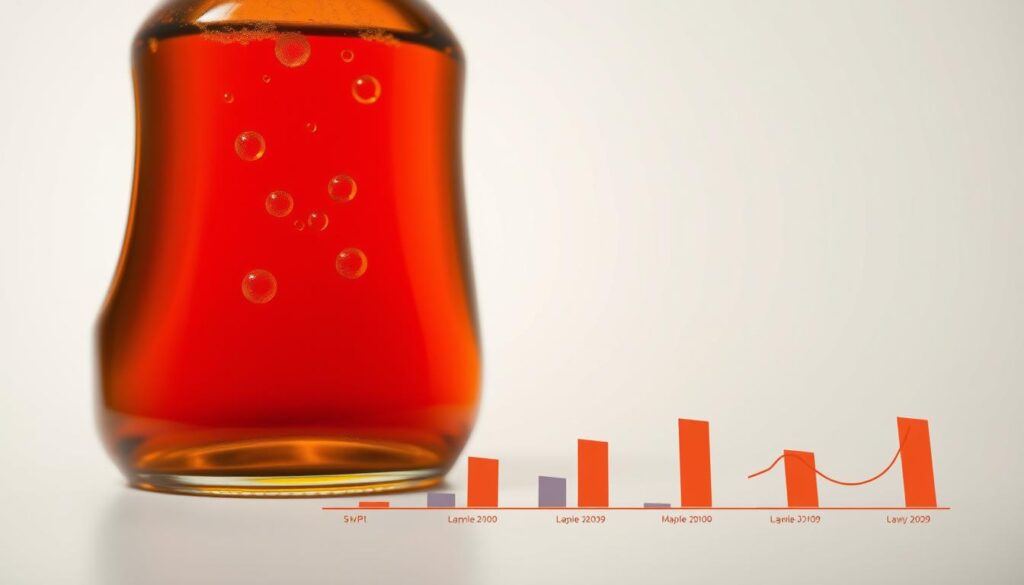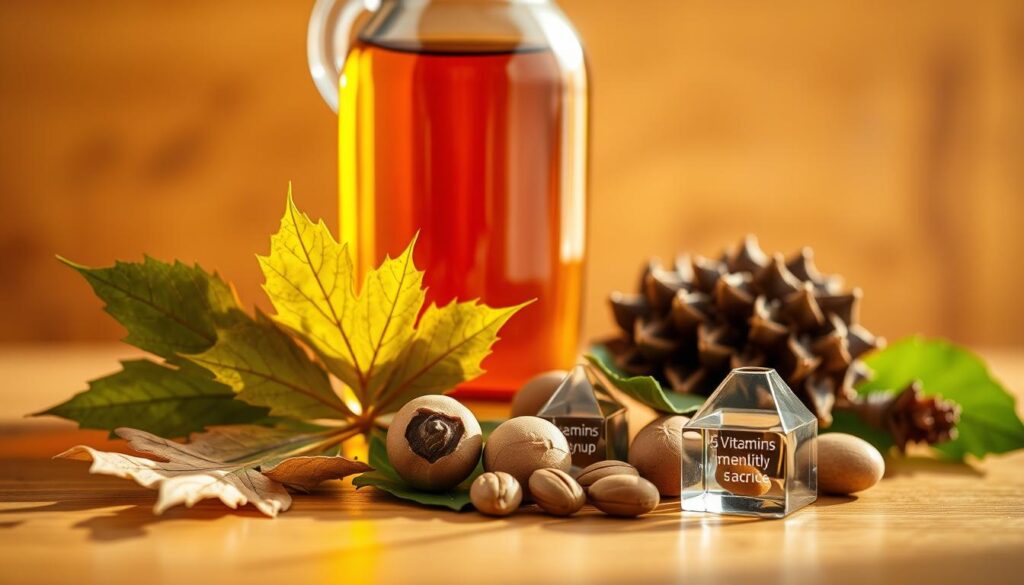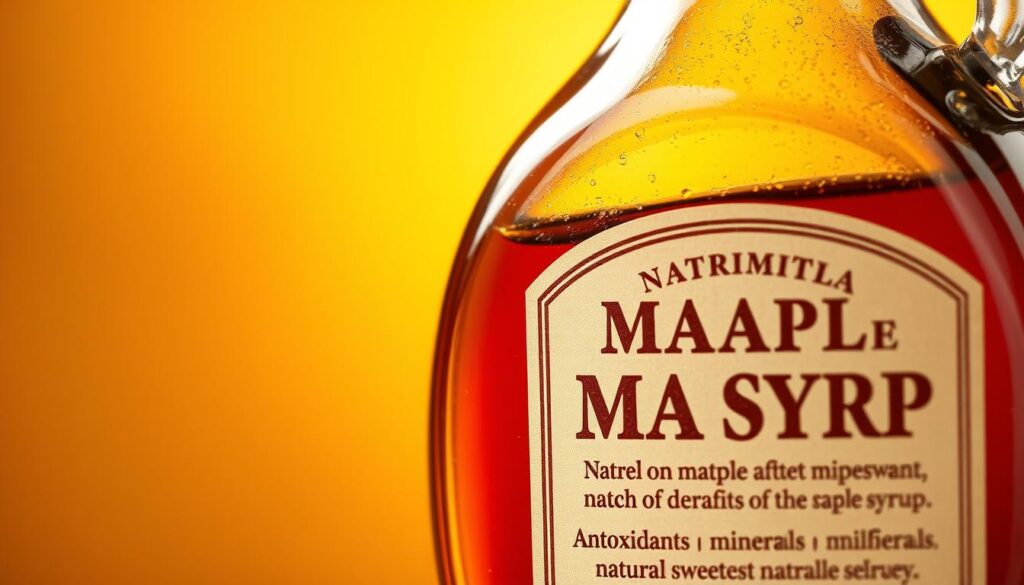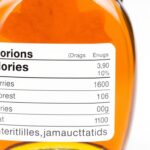Explore the world of maple syrup nutrition, a natural sweetener with surprising health benefits. This golden liquid is more than a breakfast condiment. It’s a treasure full of nutrients, coming straight from maple trees in North America.
Maple syrup nutrition is rich in minerals, vitamins, and antioxidants. It stands out from other sweeteners because it offers real nutritional value. Every drop is packed with goodness.
Maple syrup comes from the northeastern United States and eastern Canada. It’s been a favorite for indigenous people and food lovers for years. Their traditional ways of harvesting make it a health powerhouse.
Maple syrup is not just sweet. It has minerals like zinc and manganese and antioxidants for health. Sugarmakers use old methods to keep its natural goodness intact.
Discovering maple syrup’s benefits opens up a world of taste and nutrition. It’s great for baking and cooking, adding flavor and nutrients to your meals.
Understanding Pure Maple Syrup: Nature’s Sweet Gift
Maple syrup is a natural treasure from North America. It comes from the sap of maple trees. This process turns simple sap into a sweet, nutritious syrup.
The journey starts in the forests of northeastern United States. Sugar maple trees give their sap. Sugarmakers pick the right trees, balancing production and forest care.
Traditional Harvesting Methods
Harvesting maple syrup needs careful steps:
- Identifying mature maple trees with optimal trunk diameter
- Drilling small holes called tapholes in tree bark
- Inserting specialized spiles to collect raw sap
- Using collection buckets or modern pipeline systems
From Tree to Table Process
Turning sap into syrup involves several steps:
- Collecting clear, watery sap during early spring
- Transporting sap to sugar houses
- Boiling sap in large evaporators
- Filtering and bottling the concentrated syrup
Different Maple Syrup Grades
Maple syrup grades show color and flavor:
- Golden Color, Delicate Taste: Lightest grade, mild flavor
- Amber Color, Rich Flavor: Medium intensity, popular for cooking
- Dark Color, Robust Taste: Strong maple flavor, ideal for baking
- Very Dark Color, Strong Taste: Most intense maple profile
Maple Syrup Nutrition: Essential Components
Maple syrup is more than just sweet. It’s packed with nutrients that make it a healthier choice than refined sugars. Unlike other sweeteners, maple syrup has a mix of vitamins, minerals, and compounds that boost its nutritional value.
Maple syrup stands out because of its nutritional makeup. It has vitamins and minerals that offer health benefits. This makes it a better option for those looking for natural sweeteners.
- Rich in antioxidant compounds
- Contains essential maple syrup minerals
- Provides trace amounts of vital nutrients
Studies show maple syrup is full of nutrients. Its mineral content is impressive, with nutrients that support health.
| Nutritional Component | Benefit | Quantity per 100g |
|---|---|---|
| Zinc | Immune System Support | 1.47 mg |
| Manganese | Metabolism Regulation | 2.91 mg |
| Calcium | Bone Health | 102 mg |
Maple syrup’s nutrition profile is complex. It has natural compounds that make it special. While it should be eaten in moderation, maple syrup is a healthier choice than many other sweeteners.
Caloric Content and Sugar Composition
Maple syrup has a unique nutritional profile. It’s different from other sweeteners. Knowing the calories and sugar content helps us make better food choices.
Pure maple syrup has natural sugars. These sugars add flavor and energy. The sugar content includes:
- Sucrose: Main natural sugar (about 66%)
- Glucose: Quick energy source
- Fructose: Natural fruit sugar
Natural Sugar Types in Maple Syrup
Maple syrup’s sugar mix is different from refined sugars. Unlike processed sugars, it has trace minerals and antioxidants. A quarter-cup serving has about 200 calories, making it a rich energy source.
Comparing Calories with Other Sweeteners
Comparing maple syrup to other sweeteners shows interesting facts:
| Sweetener | Calories per Tablespoon |
|---|---|
| Maple Syrup | 52 |
| Honey | 64 |
| White Sugar | 49 |
Maple syrup has similar calories to other sweeteners. But, its natural origin and extra nutrients make it a better choice for those watching their health.
Glycemic Index and Blood Sugar Impact

Knowing the maple syrup glycemic index helps us make better food choices. Unlike refined sugars, maple syrup is a more natural sweetener. It might even have health benefits.
The glycemic index (GI) shows how fast foods raise blood sugar. Maple syrup has a moderate GI, which is good for health.
- Pure maple syrup usually has a GI between 54-68.
- It has a slightly lower GI than white sugar (GI of 65).
- Natural minerals in maple syrup might slow down sugar absorption.
People with blood sugar issues should use maple syrup with care. It’s important to control how much you eat. Maple syrup isn’t low in sugar, but it’s better than processed sweeteners.
Maple syrup has complex carbs and nutrients that help with metabolism.
Nutritionists say maple syrup is okay in a balanced diet. It’s better for blood sugar than many processed sugars.
Vital Minerals in Maple Syrup
Maple syrup minerals add a surprising nutritional boost to its sweet taste. This natural sweetener is packed with minerals that help keep you healthy. It’s more than just a tasty topping.
Pure maple syrup is full of essential minerals. These minerals support many bodily functions. Each golden drop of maple syrup brings valuable nutrients.
Zinc and Manganese: Powerhouse Minerals
Maple syrup minerals are rich in zinc and manganese. These trace minerals are vital for our health:
- Zinc boosts our immune system
- Manganese helps build bones
- Both minerals help with metabolism
Calcium and Potassium: Nutritional Guardians
Maple syrup also has lots of calcium and potassium. These minerals are important for our bodies:
| Mineral | Health Benefits | Concentration in Maple Syrup |
|---|---|---|
| Calcium | Keeps bones strong, supports muscles | 24 mg per 1/4 cup |
| Potassium | Helps the heart and muscles | 41 mg per 1/4 cup |
Trace Mineral Profile
Maple syrup also has many trace minerals. Each tablespoon is a mix of nutrients that boost its health benefits.
- Iron
- Magnesium
- Phosphorus
- Copper
Choosing pure maple syrup means getting a natural sweetener with real nutritional value. The minerals in maple syrup offer a tasty way to add essential nutrients to your diet.
Essential Vitamins and Nutrients

Maple syrup is more than just sweet. It’s packed with vitamins and nutrients that are good for you. Many see it as just a tasty topping, but it’s actually very nutritious.
Maple syrup has vitamins that help our bodies work right. It has compounds that make it stand out from other sweeteners.
- Vitamin B Complex: Maple syrup contains trace amounts of important B vitamins
- Riboflavin (Vitamin B2): Supports energy metabolism
- Pantothenic acid (Vitamin B5): Helps in hormone and cholesterol production
- Niacin (Vitamin B3): Supports nervous system health
Nutrition experts say maple syrup is more than empty calories. The nutrient density of pure maple syrup makes it a more intelligent choice compared to refined sugar. It has a bit of vitamins, but it’s better than other sweeteners.
Pure maple syrup offers a natural source of nutrients that synthetic sweeteners simply cannot match.
Maple syrup also has minerals that are key for health. These nutrients make maple syrup a great choice for those looking for natural food options.
Even though maple syrup vitamins are in small amounts, they add to its nutritional value. Opting for pure, high-quality maple syrup ensures you get the most health benefits from it.
Antioxidant Properties and Compounds
Maple syrup antioxidants are key in protecting our bodies. They fight off harmful free radicals. These free radicals can cause health problems.
Maple syrup is special because of its health benefits. It has lots of antioxidants that help keep us well. These antioxidants are found in pure maple syrup.
Phenolic Compounds: Nature’s Protective Molecules
Phenolic compounds in maple syrup are amazing. They protect our health in many ways. They:
- Neutralize harmful free radicals
- Support cellular protection
- Reduce oxidative stress
- Potentially lower inflammation markers
Free Radical Fighting Benefits
The antioxidants in maple syrup fight free radicals well. Scientifically speaking, they stop harmful cell damage. They help our bodies fight off harm.
Maple syrup has more antioxidants than other natural sweeteners. The darker the syrup, the more antioxidants it has. This makes darker syrup better for you.
Nature’s sweetest protection comes from the remarkable antioxidant properties found in pure maple syrup.
Health Benefits and Wellness Properties

Maple syrup is more than just sweet. It has wellness benefits that make it a special natural sweetener. It should be eaten in small amounts, but it has nutrients that help your health.
The health benefits of maple syrup include:
- Rich in antioxidant compounds that fight cellular damage
- Has essential minerals like zinc and manganese
- Offers natural energy with less sugar impact than refined sugars
- Helps the immune system with trace minerals
Studies show maple syrup has many polyphenols. These are natural compounds that could protect your health. They might lower inflammation and help your heart.
“Maple syrup is not just a sweetener, but a natural food with wellness benefits,” says nutrition expert Dr. Sarah Roberts.
Maple syrup is not a magic food, but it’s better than processed sugars. The trick is to eat it in small amounts as part of a healthy diet.
If you’re looking for a natural sweetener with extra nutrients, maple syrup is a good pick. It has minerals, antioxidants, and natural sugars. This makes it a better choice than regular refined sugars.
Culinary Applications and Cooking Tips
Maple syrup is more than just a sweetener for pancakes. It’s rich in flavor and nutrients, making it great for both sweet and savory dishes. It can turn simple recipes into something special.
Maple syrup is a healthier choice for cooking. It lets home cooks swap out refined sugars for a better option. Its natural sweetness boosts many recipes and adds important minerals.
Baking with Maple Syrup
Maple syrup can replace sugar in baking with a few tweaks:
- Reduce liquid ingredients by 1/4 cup for every cup of maple syrup used
- Lower oven temperature by 25 degrees to prevent over-browning
- Use pure maple syrup for best flavor and nutritional benefits
It’s perfect for cakes, cookies, muffins, and bread. Maple syrup adds depth and complexity to baked goods.
Savory Dish Applications
Maple syrup is also great for savory dishes. Its complex flavor is perfect for:
- Glazing roasted vegetables
- Marinading meats like chicken and pork
- Creating salad dressings with a subtle sweetness
- Enhancing barbecue sauces
Chefs love maple syrup for balancing salt and adding caramelized notes. It’s a favorite in both professional and home kitchens.
Maple Syrup vs. Artificial Sweeteners
Maple syrup is a natural choice compared to artificial sweeteners. It offers more than just sweetness. It has a nutritional profile that artificial sweeteners can’t match.
Artificial sweeteners may pose health risks that maple syrup does not. Maple syrup’s natural makeup gives it health benefits that chemical substitutes lack.
- Natural mineral content in maple syrup
- Zero artificial chemical additives
- Lower glycemic impact compared to refined sugars
- Rich in antioxidants and trace nutrients
“Nature’s sweetener provides more than just taste – it delivers nutrition with every drop.” – Nutrition Experts
Maple syrup contains genuine nutrients that artificial sweeteners completely lack. Zero-calorie sweeteners might seem appealing, but they offer no nutritional value. They may also have unknown long-term health effects.
The main differences between maple syrup and artificial sweeteners are:
- Nutritional Content: Maple syrup has zinc, manganese, and antioxidants
- Metabolic Response: Natural sugars versus chemical compounds
- Taste Profile: Rich, authentic flavor versus synthetic sweetness
Choosing maple syrup means picking a wholesome, minimally processed sweetener. It supports overall wellness with its natural benefits.
Storage and Shelf Life Guidelines
Keeping maple syrup quality up requires careful storage. The right handling and preservation are key. This ensures its unique taste and nutrients stay intact.
- Always store in a cool, dark place before opening
- Use airtight containers to prevent contamination
- Refrigerate after opening to extend shelf life
- Keep away from direct sunlight and heat sources
Optimal Storage Conditions
Each maple syrup type needs its own storage method. Glass or food-grade plastic containers are best for keeping it fresh.
| Syrup Type | Unopened Storage | Opened Storage |
|---|---|---|
| Pure Maple Syrup | Cool, dark pantry | Refrigerate |
| Commercial Maple Syrup | Room temperature | Refrigerate after opening |
Identifying Spoilage
Spotting spoilage is important for syrup’s nutrition and safety. Look out for these signs:
- Mold growth on surface
- Off-putting smell
- Unusual color changes
- Crystallization or fermentation
If unsure, throw out the syrup for safety. Storage can keep it fresh for up to a year unopened. After opening, it lasts several months in the fridge.
Sustainable Production and Environmental Impact
Maple syrup is more than just tasty. It shows how farming can be kind to forests. Sugarmakers use methods that keep forests healthy while they make syrup.
Maple syrup also helps the planet. Maple forests help fight climate change by absorbing carbon. They also give homes to many animals and keep nature in balance.
- Forest conservation through responsible tapping
- Minimal impact harvesting techniques
- Protection of tree health during syrup production
- Maintenance of woodland biodiversity
Producing maple syrup in a green way means careful forest care. Traditional tapping methods keep trees healthy for many years. Today’s sugarmakers use new tech to help trees and get more syrup.
Maple forests are a gift to both the earth and people. Each tree can be tapped many times, letting it keep growing and giving sap. This shows how farming and nature can work together well.
“Sustainable maple syrup production is about preserving nature’s delicate balance while enjoying its sweet gifts.”
Maple syrup making is better for the planet than many other farming ways. It helps forests stay healthy and full of life. Choosing maple syrup is a smart choice for the earth.
Buying Guide: Choosing Quality Maple Syrup
Choosing the right maple syrup is key. It’s not just for sweetening your coffee. It’s about finding the perfect syrup for your cooking and health needs.
When you go shopping for maple syrup, look closely. Think about how it tastes and what it does for your health.
Decoding Maple Syrup Labels
Maple syrup labels tell you a lot. Here’s what to look for:
- Grade classification (Light, Medium, Dark, Very Dark)
- Maple syrup sugar content percentage
- Organic certification
- Harvest location
- Production date
Understanding Price Considerations
Maple syrup prices change for many reasons. Here’s a guide to help you understand:
| Maple Syrup Grade | Average Price Range | Key Characteristics |
|---|---|---|
| Grade A Light Amber | $12-$18 per 16 oz | Delicate flavor, ideal for baking |
| Grade A Dark Amber | $15-$22 per 16 oz | Robust flavor, great for cooking |
| Grade B | $18-$25 per 16 oz | Intense maple flavor, perfect for marinades |
Don’t just look at the price. Think about where it’s from, how it’s made, and how you’ll use it.
Pro tip: Pure, locally made maple syrup is usually the best choice for taste and health.
Conclusion
Maple syrup is more than just a sweetener. It’s packed with minerals, antioxidants, and special compounds. This makes it a great choice over refined sugars.
Maple syrup has many health benefits. It’s full of zinc, manganese, and antioxidants. These nutrients make it a better option for those looking for a healthier sweetener.
It’s perfect for cooking and adds flavor to many dishes. Maple syrup is not just tasty but also good for you. Eating it in moderation can make your diet better.
Maple syrup is a top choice for those who prefer natural foods. It’s made in a way that’s good for the environment and has a rich history. Knowing its nutritional value helps people make better food choices.



